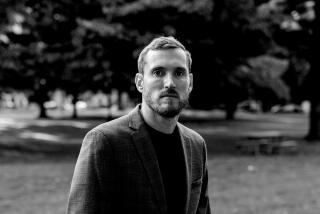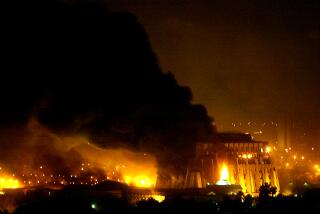Writers Who Have Gone Before Us Evoke Afghanistan’s Past and Present
- Share via
A friend recently sent me a passage from “A Lament for Afghanistan,” by British novelist and travel writer Bruce Chatwin. The short essay, published in “What Am I Doing Here” (Penguin Books, 1989), was written in 1980 and recalls the author’s travels there in 1962, before the country was “wrecked,” as Chatwin puts it, by the arrival of hippies from the West (who, he says, encouraged educated Afghans to take up Marxism, presumably leading to the Soviet invasion of 1979).
The essay, which is really a eulogy for a lost beloved land, brings vividly to mind a host of wonderfully exotic and archaic people and places, from Genghis Khan to the Buddhas at Bamian. Though I knew little more about Afghanistan than I had learned from the 1975 John Huston movie “The Man Who Would Be King” (based on the Rudyard Kipling novel and set in Kafiristan, now called Nuristan in eastern Afghanistan), Chatwin’s essay awakened in me the desire to see this country locked in the heart of Central Asia.
It’s foolish, of course. Never mind the wreckage Chatwin blames on hippies. Foreign invasions and warfare have kept Afghanistan off most tourist itineraries for decades. How much more dangerous, demoralized and dilapidated must it be now, after U.S. bombing, the exodus of millions of Afghans to neighboring countries and the demise of the Taliban?
Because I wouldn’t be going to Kabul, I turned to travel writers to take me on a tour and found that some of the best, like Chatwin, have been drawn to Afghanistan, although--or maybe because--it has long seemed so forbidding.
The beauty of this mode of travel was that one writer often suggested another. Chatwin fashioned his trip on that of Robert Byron, an English devotee of Islamic art, who chronicles his 1933 journey, part of it across Afghanistan, in “The Road to Oxiana” (Oxford University Press, 1982). In this wittily instructive book, Byron tells of his arrival in the city of Herat near the Iranian border, of Tajiks in quilted gowns, the black-booted Turkmen and the occasional “calico beehive with a window at the top.... This is a woman. Hawk-eyed and eagle-beaked, the swarthy loose-knit men swing through the dark bazaar with a devil-may-care self-confidence. They carry rifles to go shopping as Londoners carry umbrellas.”
Byron also describes Herat’s Musalla, a minaret complex largely built in the 15th century by Gohar Shad Begum, the wife of a shah, during a flowering of Islamic art but largely destroyed in 1885. At Gazar Gah, a pleasure garden in Herat, he finds the grave of Emir Dost Mohammed, whom the British deposed in the disastrous First Afghan War of 1839-42.
By touring car and horse, Byron travels from Herat to Balkh, in northern Afghanistan, capital of a kingdom that predated the Central Asian conquests of Alexander the Great, left in ruins first by Genghis Khan, then by Russian Bolsheviks. He camps amid wasps, scorpions and snakes in the marshes of Kunduz. Because of hostilities on the frontier, Byron isn’t allowed to see the Amu Darya River (also known as the Oxus), which separates Afghanistan from Turkmenistan to the north, empties into the Aral Sea and irrigates Central Asia, with an annual flow four times that of the Colorado.
He does visit the two colossal Buddhas carved into a cliff in the 3rd and 5th centuries at Bamian, 80 miles northwest of Kabul. Considered idols by the Taliban, these statues, prized for their blending of Western classical and Indian artistic styles, were blown up last year. When Byron sees them, they have been defaced.
The Englishman doesn’t much care for the Buddha sculpture of Bamian (“Its art is unfresh,” he writes). But crossing the Hindu Kush by way of 9,800-foot Shibar Pass takes his breath away. (He finds the famed Khyber Pass on Afghanistan’s eastern border “invitingly mild” by comparison.)
In my imagination, I crossed the mountain range that bisects eastern Afghanistan, with peaks topping 25,000 feet, in the company of Irish travel writer Dervla Murphy, who biked alone across Afghanistan in 1963 and describes the wild ride in “Full Tilt” (John Murray, 1965). Murphy’s ascent of Shibar Pass leaves her breathless and aching. “But it was worth it all to rise gradually ... to the still, cold splendor of the snow-line, where the highest peaks of the Hindu Kush crowd the horizon in every direction and one begins to understand why some people believe that gods live on mountain tops,” she writes.
The Afghan capital of Kabul, as it was in the early 19th century, comes alive for me in “Tournament of Shadows: The Great Game and the Race for Empire in Central Asia,” by Karl E. Meyer and Shareen Blair Brysac (Counterpoint, 1999). In this highly readable history, the authors tell the story of the First Afghan War, waged by England to assure the loyalty of Afghanistan, thus protecting India’s northwestern flank.
Though British troops easily took Kabul in 1839, installing their ally, Shah Shoja, and his hundreds of wives in the nearby hilltop citadel of Bala Hissar, the Afghans were far from pacified. Riots erupted in Kabul in 1841, British officials were killed, and the retreating army was cut to pieces by Afghan sharpshooters atop the Jagdalak Pass, between Kabul and Jalalabad.
Now that I know these bits of Afghanistan’s storied past, I want to go there all the more. I would like to see Jagdalak and Shibar, the remains of Herat’s minarets, the rubble of Bamian’s Buddhas, the Amu Darya River and the National Museum in Kabul, where the Taliban smashed thousands of statues. I want to see the remains with my own eyes. Until then, I won’t believe the country is wrecked.
More to Read
Sign up for our Book Club newsletter
Get the latest news, events and more from the Los Angeles Times Book Club, and help us get L.A. reading and talking.
You may occasionally receive promotional content from the Los Angeles Times.










